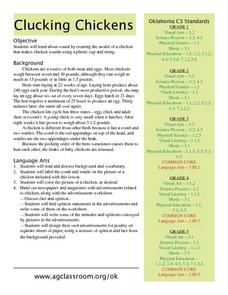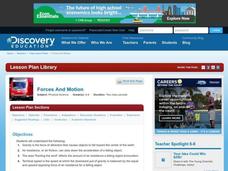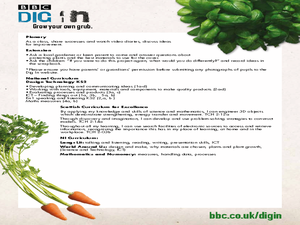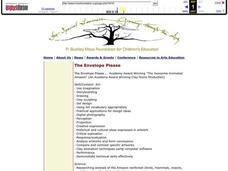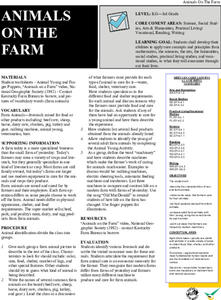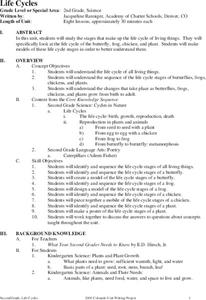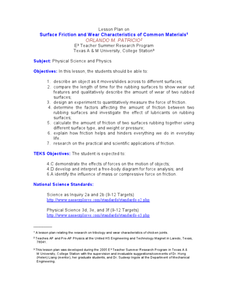Curated OER
Hatching Chickens
Students observe how chickens hatch. In this life cycles instructional activity, students read the book Hatching Eggs: A Step by Step Guide and use an incubator to hatch the eggs. Students observe the chicks hatching and take care of the...
Curated OER
Clucking Chickens
A comb, wattle, and beak are three characteristics that describe a chicken. Your class can explore the life of a chicken through reading, art, movement, and music. Using a plastic cup and string, they'll create a pretend chicken that...
Curated OER
The Birds of a Feather Flock Together
Fifth graders identify all parts of an egg, and explore their importance to the life cycle of a chicken. Learners compare all sorts of birds and place them in categories based on what they look like. This five-day activity effectively...
Curated OER
Transportation Systems: Two Liter Boat Activity
Students design and build full-size boats made out of two-liter plastic bottles, chicken wire, and plywood. Then they race the boats, with the boat's designers "manning the hull", in the school's swimming pool.
Curated OER
Poultry and Eggs
Egg-cellent! A series of lessons on eggs awaits your class. They study everything from how eggs are formed in a chicken's body to how well they float, how to determine if they are raw or cooked, the strength and construction of the...
Curated OER
Forces and Motion
Students build parachutes for chicken eggs. For this physics lesson, students describe the forces acting on a falling object. They predict which of the three parachute models they made has the best chance of keeping the egg intact after...
Curated OER
Inside the Egg, Hatching Chickens
Students conduct an egg candling activity to show the life inside a fertile egg. Students discuss the needs the egg has of the hen, as well as similarities and differences between plants and animals. Students complete a life cycle wheel...
Curated OER
Agriculture: Oklahoma's Legacy
Sixth graders explore agriculture as it relates to crops over the course of a series of historical events. They read and create a timeline of the 50-year increments that depict important cause and effect events. Students then use...
Curated OER
ACTIVITY 6: MAKE A FOSSIL MOLD AND CAST and ACTIVITY 7: HOW BIG WERE PREHISTORIC ANIMALS?
Instructions for two terrific ancient history lessons for your primary paleontologists are provided in this resource. The first involves the creation of fossil cast replicas using plaster of Paris. The directions are detailed, but the...
Curated OER
A Lucky Break
Students complete activities where they identify and decipher common phrases that are related to poultry and then cook drumsticks as a class. In this poultry lesson plan, students also read the history of the chicken and create idioms.
Curated OER
Embryo Development
Students observe the development of a chicken embryo. In this biology lesson, students compare and contrast the development of human and chick embryo. They make a chart and explain their findings to the class.
Curated OER
Farm Products Help Me Grow
Learners view a display of empty food containers (or illustrations). They select a food and decide as a class if it has an animal or plant origin. Students view a display of common farm animals that are commonly eaten (cow, pig, chicken,...
Curated OER
The Day an Egg Solved the Mystery of the Cell
Young scholars conduct an experiment comparing human cells to chicken cells. In this cells lesson plan, students conduct an experiment to see how nutrition moves through cells and how to better take care of their bodies.
Curated OER
Design Technology- Grow Your Own Grub
Students design a protective cover for outdoor plants. In this agricultural instructional activity, students use chicken wire, plastic sheeting, and empty bottles to construct a cover for lettuce leaves. Students take digital photos of...
Curated OER
Make a Farm
After a class discussion about where their food comes from learners construct a farm from a print-out (embedded in the plan). They work in groups, and trace a food source from the beginning. For example, they discover how a farmer grows...
Curated OER
The Envelope Please
Students research an animal of the rainforest. They create a computerized claymation to present their research.
Curated OER
Animals on the Farm
Students work in groups to create a description of a farm animal. Other classmates try to guess the animal. The class discusses what farmers need to provide for each animal on their farm (food, shelter, veterinary care). Students...
Curated OER
Step by Step
Young scholars explore agriculture by creating a food production diagram. In this farming lesson, students read assigned text about the entities that assist in food production companies such as farmers, truckers and supermarkets. Young...
Curated OER
Egg Structure Project
Students investigate the physical structure of an egg and the functions of the seven parts. They create a diagram and discuss each part of the egg while looking for the information, Complete lesson materials are found at a website listed...
Curated OER
Life Cycles
Students explore the life cycle of living things through the eight lessons of this unit. The butterfly, frog, chicken, and plant are inspected and form the basis of the work done in this unit.
Curated OER
Skeletal System (Continued)
Learners examine human bones. In this skeletal system lesson, students review the functions and locations of bones in the human body. Learners work in groups to complete an activity where they discover why bones are hollow and discuss...
Curated OER
Let's Go to the Farm!
Discover the animals which live on a farm through listening to a story about farm animals and conduct a simple research. Youngsters will create a class Web site about farm animals and provide information about each animal.
Curated OER
MuscleMania
Middle schoolers learn three different types of muscles. By building a model of the arm, they learn its basic anatomy and how muscles function in relationship to bones. They perform an experiment on the relationship between muscle size...
Curated OER
Surface Friction and Wear Characteristics of Common Materials
Students identify the factors affecting friction. In this physics lesson, students construct their own rocket car and race them. They graph the average speeds and discuss how lubricants affect friction between rubbing surfaces.

